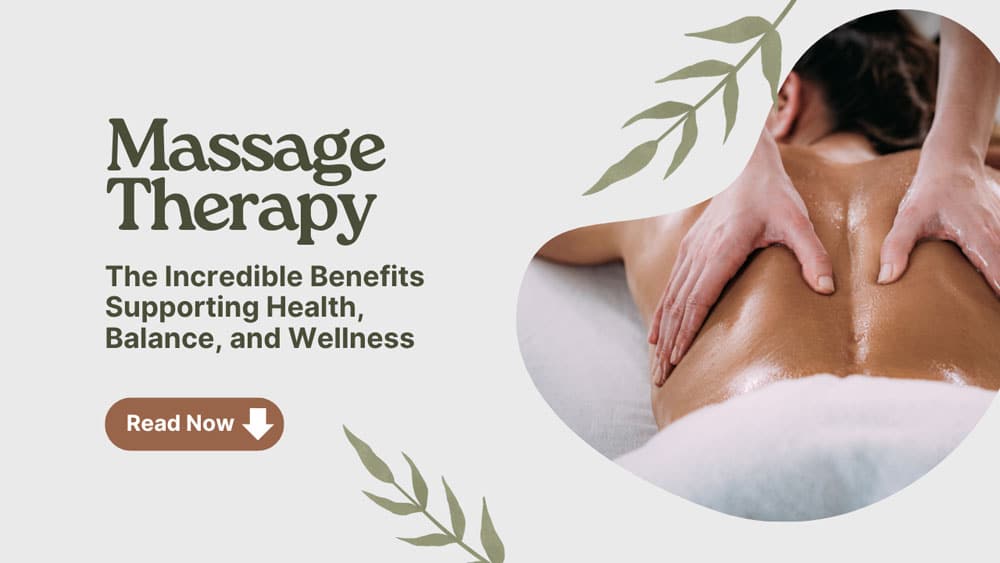
The Incredible Benefits of Massage Therapy: Supporting Health, Balance, and Wellness
In today’s fast-paced world, our bodies and minds face constant stress, tension, and strain. From long hours at a desk to the emotional pressures of daily life, it’s easy for both physical and mental health to take a backseat. This is where massage therapy shines—not just as a luxury or indulgence, but as an essential component of holistic health. Far more than a relaxing experience, massage therapy offers numerous benefits that support overall wellness, restore balance, and enhance quality of life.
Whether it’s therapeutic massage, relaxing massage, hot stone therapy, craniosacral work, or manual osteopathy, there is a type of massage suited to virtually every need. Understanding these benefits helps highlight why massage therapy should be considered a cornerstone of personal health care.
Therapeutic Massage: Healing Through Targeted Care
Therapeutic massage focuses on addressing specific medical or physical concerns. It’s commonly recommended for individuals dealing with chronic pain, injuries, or conditions such as arthritis, fibromyalgia, or muscular imbalances. A skilled massage therapist uses techniques designed to relieve tension in targeted areas, improve circulation, and encourage tissue repair.
One of the key benefits of therapeutic massage is its ability to reduce muscle stiffness and discomfort. By applying focused pressure and manipulating soft tissues, massage therapists help break up scar tissue, ease muscle knots, and restore mobility. For athletes or physically active individuals, this type of massage can be especially valuable in preventing injuries and speeding recovery after intense workouts.
Moreover, therapeutic massage has a strong impact on stress reduction. Chronic pain often contributes to anxiety and low mood, and relieving that discomfort can create profound mental and emotional relief. This makes therapeutic massage not only a treatment for the body but also a support for mental wellness.
Relaxing Massage: Stress Relief and Mental Clarity
While therapeutic massage targets specific ailments, relaxing massage focuses on overall stress reduction and mental calm. In our modern lives, stress can accumulate silently, affecting sleep, digestion, and even heart health. A relaxing massage provides a sanctuary from the pressures of daily life, allowing the body and mind to unwind.
Through gentle, flowing techniques, a relaxing massage stimulates the parasympathetic nervous system—the part of the nervous system responsible for rest, recovery, and digestion. This slows the heart rate, lowers blood pressure, and encourages a state of deep relaxation. People who regularly enjoy relaxing massages often report feeling more centered, clear-minded, and resilient in handling daily stressors.
In addition, relaxing massage releases endorphins, the body’s natural “feel-good” chemicals. This not only improves mood but also enhances overall energy and motivation. In essence, it’s like hitting the reset button for both body and mind.
Hot Stone Massage: Deep Relaxation and Circulation
Hot stone massage combines the soothing effects of warm stones with traditional massage techniques. Smooth, heated stones are placed on key points of the body, such as the back, shoulders, and palms, and used as tools to massage muscles. The warmth penetrates deep into muscle tissue, loosening tight areas and promoting circulation.
One of the most remarkable benefits of hot stone massage is its ability to relieve deep muscular tension that standard massage may not reach. The heat allows therapists to work more effectively on knots and stiffness while enhancing relaxation. This type of massage is also particularly helpful for individuals with chronic stress, insomnia, or circulatory issues.
Additionally, hot stone therapy is highly calming, making it an excellent choice for those seeking both physical relief and mental serenity. Many clients describe a profound sense of comfort and well-being after a session, noting reduced anxiety and improved sleep quality.
Craniosacral Therapy: Gentle Alignment for Whole-Body Health
Craniosacral therapy is a subtle and gentle approach that focuses on the body’s craniosacral system—the membranes and fluids surrounding the brain and spinal cord. Therapists use light touch to release tension, improve the flow of cerebrospinal fluid, and support the nervous system’s optimal function.
This type of massage is particularly beneficial for those dealing with headaches, migraines, stress, and trauma-related tension. By gently encouraging balance within the craniosacral system, clients often experience relief from chronic pain, improved mental clarity, and a deep sense of calm.
Unlike more intense forms of massage, craniosacral therapy is gentle enough for all ages, making it suitable for children, seniors, and even those recovering from injury or illness. Its focus on the nervous system highlights how massage can impact more than muscles—it can nurture the body’s entire regulatory and restorative systems.
Manual Osteopathy: Structural Support and Functional Health
Manual osteopathy, or osteopathic massage, emphasizes the body’s structure and mechanics. Osteopathic practitioners use hands-on techniques to improve alignment, increase joint mobility, and promote healthy circulation. The goal is to enhance the body’s natural ability to heal itself while relieving tension and restoring balance.
This approach can benefit those with postural issues, chronic pain, or restricted mobility. By addressing skeletal and muscular alignment together, manual osteopathy not only eases discomfort but also prevents future injury. Many people find that combining osteopathic work with other forms of massage creates a comprehensive wellness routine that supports both structural integrity and muscle health.
Beyond physical improvements, manual osteopathy also enhances energy flow throughout the body. When alignment and function are optimized, the body can operate more efficiently, supporting overall vitality and resilience.
Massage Therapy as a Holistic Health Practice
While each type of massage offers unique benefits, one unifying theme is that massage therapy is a powerful addition to overall health care. Unlike medications or isolated treatments, massage supports multiple aspects of well-being simultaneously—physical, mental, and emotional.
Regular massage therapy can:
-
Reduce stress and anxiety
-
Improve circulation and cardiovascular function
-
Relieve chronic pain and tension
-
Support immune system health
-
Enhance mental clarity and focus
-
Promote better sleep
-
Improve flexibility and joint mobility
-
Foster a sense of relaxation and emotional balance
Incorporating massage into a weekly or monthly routine can create cumulative benefits. Over time, clients often notice enhanced energy, resilience to stress, and reduced likelihood of injury or chronic discomfort. Massage therapy encourages the body to function more efficiently, supporting natural healing and overall wellness.
Combining Massage with Daily Health Practices
Massage therapy works best when paired with other healthy habits. Proper nutrition, regular exercise, hydration, and mindfulness practices amplify the benefits of massage. For example, a therapeutic massage can relieve muscle tension caused by intense workouts, while a relaxing massage can complement meditation or yoga by enhancing mind-body awareness.
Furthermore, massage therapy is not just a short-term relief strategy—it’s a preventive approach to health. By regularly addressing muscle imbalances, joint tension, and stress, massage helps maintain a higher baseline of physical and mental well-being. Think of it as an investment in your body’s future performance and longevity.
Choosing the Right Type of Massage
With so many types of massage available, it’s important to match your goals with the technique.
-
Therapeutic massage: Ideal for injury recovery, chronic pain, or targeted relief.
-
Relaxing massage: Best for stress reduction, improved sleep, and general relaxation.
-
Hot stone massage: Deep muscle tension relief and enhanced relaxation through heat therapy.
-
Craniosacral therapy: Gentle nervous system support, ideal for headaches, trauma, or anxiety.
-
Manual osteopathy: Focuses on structural alignment, joint mobility, and overall function.
A professional massage therapist can help determine the best approach based on your unique needs, ensuring that each session provides maximum benefit.
Making Massage Therapy a Part of Your Life
The evidence is clear: massage therapy is more than a luxury—it is a key component of a holistic wellness routine. By integrating massage into your life, you’re supporting your body’s natural healing processes, reducing stress, and enhancing mental clarity.
Even short, regular sessions can have a significant impact on overall well-being. Many clients report feeling lighter, more flexible, and more centered in their daily lives. Over time, the benefits compound, improving long-term health outcomes and fostering a stronger connection between body and mind.
Massage therapy is also a wonderful form of self-care, providing a space to slow down, breathe, and reconnect with your body. In a world filled with constant demands, it reminds us that nurturing our physical and mental health is essential—not optional.
Conclusion
From therapeutic and relaxing massage to hot stone therapy, craniosacral work, and manual osteopathy, the benefits of massage therapy are wide-ranging and profound. It alleviates pain, reduces stress, supports cardiovascular and immune health, and enhances mental clarity. More than that, it nurtures a sense of well-being that extends far beyond the massage table.
Incorporating massage into your health routine is a proactive step toward maintaining balance, promoting healing, and achieving a higher quality of life. Whether seeking relief from chronic pain, better stress management, or simply a restorative break from daily pressures, massage therapy offers a safe, effective, and human-centered approach to total-body wellness.
Ultimately, massage is an investment in yourself—a simple yet powerful practice that supports the body, mind, and spirit. By making it a regular part of your lifestyle, you embrace a holistic path to health that is both restorative and preventative, helping you feel your best now and for years to come.







